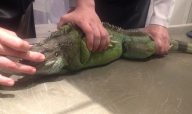Os avanços da Tomografia Abdominal, por Dr Tobias Schwarz
9 de novembro de 2016 |
No Rio, em janeiro de 2017, para comandar o Curso Internacional Avançado de Tomografia Abdominal, Dr Tobias Schwarz é uma das mais importantes — senão a maior — referência em tomografia veterinária no mundo. Nesta entrevista concedida com exclusividade ao Blog do CRV Imagem, Dr Schwarz, que integra a Royal School of Veterinary Studies, na Escócia, discute a importância prática da tomografia abdominal, os casos em que deve ser adotada (em detrimento da ultra e dos raios-x) e a sua aplicação em cachorros de pequeno e grande porte.
Dr Schwarz é autor do Veterinary Computed Tomography, um dos livros mais completos sobre tomografia veterinária.
Professor Schwarz, considering your extensive experience, what makes abdominals Computed Tomography (CT) studies so important for the clinicians and what are the most common abdominal cases on your routine?
Abdominal CT allows visualisation of all abdominal organs, the pelvic canal and of course other relevant body parts such as the thorax with very high detail in a very quick way.
Abdominal CT is much more sensitive than abdominal radiography. Compared to ultrasound, the advantage of CT is that the entire abdomen is covered, image acquisition is user-independent, no clipping is required, and that some areas, such as ureters and urethra can be assessed, which is not the case with ultrasound. On the other hand ultrasound is still a very cost effective and quick examination in experienced hands, does not require general anaesthesia, and allows FNA or biopsy of abdominal lesions, which is more difficult to do with CT.
A good example is a urinary work-up. Previously we would have done a radiographic IVU, combined with a double contrast cystography and followed by a retrograde urethrogram / vaginogram, potentially in combination with urological ultrasound. Now we perform a one-stop Uro-CT-examination to cover the entire urinary system. If a patient needs an FNA/ BX we would add a short targeted ultrasound examination to do this. This has made our workflow and diagnostic outcome much more efficient.
Contrasted studies of the abdomen are of great use in human medicine and veterinary practice. Could you comment a little about the importance of vascular studies with the advancement of multi-slice equipment?
Vascular disorders, such as portosystemic shunts are relatively common disorders in dog and they are often complex and require detailed information for surgical decision making. This is where multi-slice CT can be an excellent diagnostic tool, allowing detailed assessment of all vascular systems in the abdomen. Multi-slice CT allows coverage of a larger area with thin-slice images, delivering excellent anatomic detail.
Conteúdo Relacionado: CRV entrevista Dr Mauro Caldas.
In your opinion, for which abdominal diseases CT is more helpful than ultrasound? Any consideration between small and large breed dogs?
I think that abdominal CT is superior to ultrasound in any large breed dog, particularly if they are also obese. It just delivers better and more consistent anatomical detail for these dogs. In very small dogs and in cats it depends on the organ in question. In general I think that CT is the modality of choice for pathology in different body parts that are not all accessible for ultrasound. As mentioned before urological CT is superior if the entire urological system is to be examined.
—












Comentários